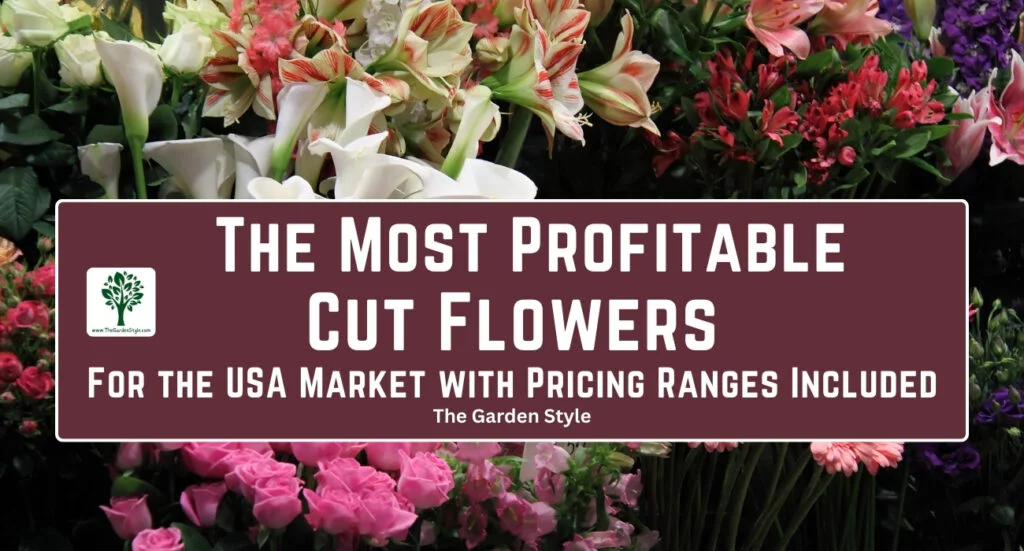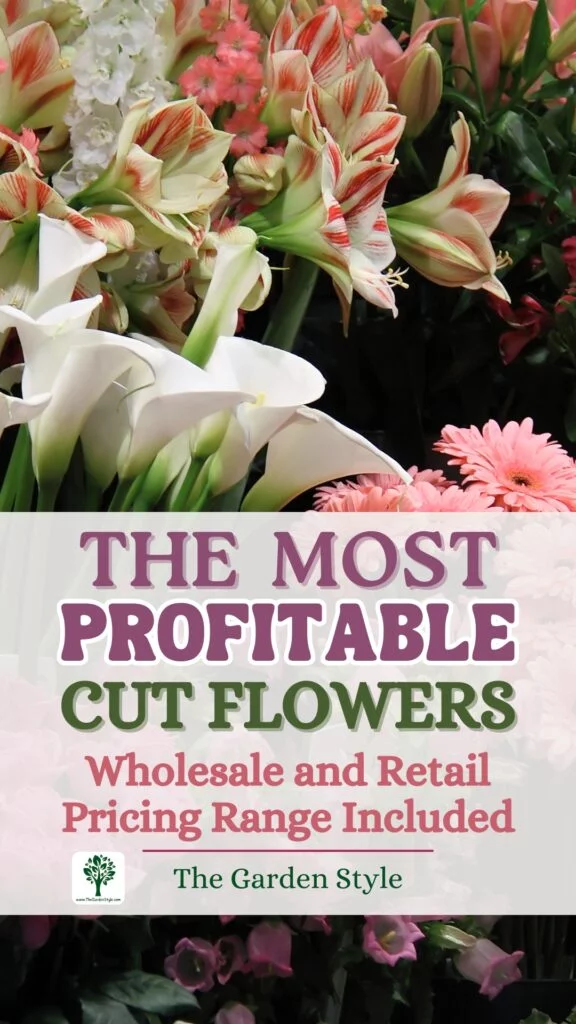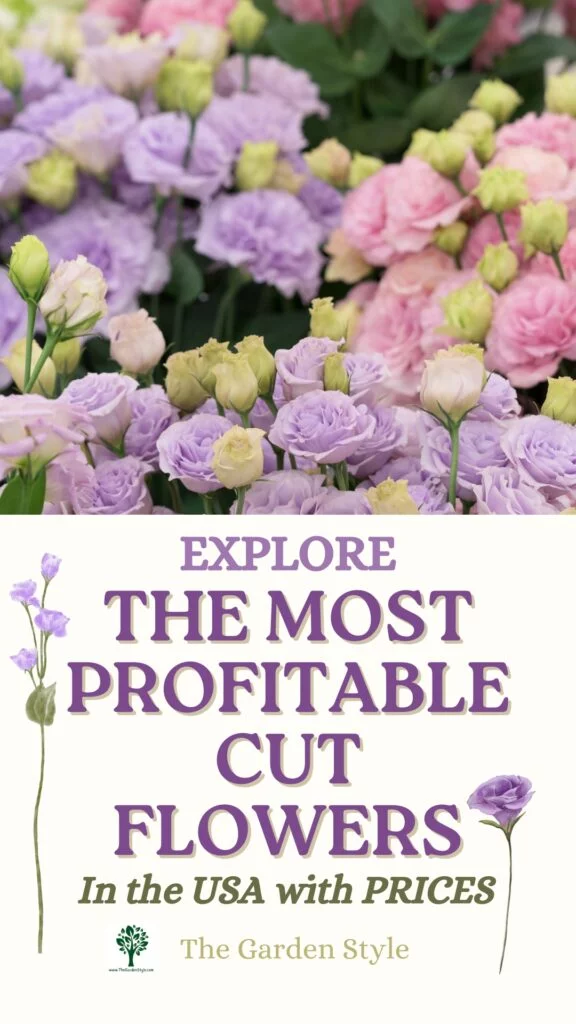The profitability of cut flowers can vary greatly depending on several factors, such as market demand, year trends, growing conditions, and the grower’s expertise. The most profitable cut flowers are often related to cultural customs in each country. For instance, while in Italy, it is customary to gift mimosas flowers on International Women’s Day. As a point of contrast, traditionally, in the United States, roses, tulips, or mixed floral arrangements are popular gifts for International Women’s Day, whereas, in Spain, it is common to gift lilies, carnations, and roses. Therefore, the list of the 23 most profitable cut flowers with wholesale and retail pricing ranges in this article is tailored to the United States market, based on 2023 and 2024 data.
As usual, it’s recommended that flower farmers conduct their own research and trials to determine what works best for their unique situation. As much as possible, diversifying the cultivation of flowers and not growing only one type of flower is a very appropriate strategy. In case of a specific flower disease, you could lose all your investment.
Table of Contents
Most Profitable Cut Flowers
Here’s the list of some of the most profitable cut flowers in the USA for 2024, based on 2023 data, organized from A to Z:
- Alstroemeria
- Amaranth
- Carnations
- Celosia
- Chrysanthemums
- Dahlias
- Delphinium
- Gerbera Daisies
- Gladiolus
- Gomphrena
- Heritage Roses
- Icelandic Poppies
- Lilies
- Lisianthus
- Ranunculus
- Rudbeckia (also known as Black-eyed Susans)
- Scabiosa
- Snapdragons
- Sunflowers
- Sweet Peas
- Tulips
- Yarrow
- Zinnias
As explained before, keep in mind that prices can vary based on location, season, year-trend, and supplier.
Understanding the Dynamics of Cut Flower Profitability and Cultivation Efforts
Cut flower profitability hinges on a delicate balance between production costs and market demand. While certain flowers may command higher prices due to their aesthetic appeal or seasonal scarcity, the actual profitability depends on various factors, including cultivation expenses, labor inputs, and market fluctuations.
The cultivation of cut flowers can vary significantly in terms of difficulty and labor requirements. Some flowers, such as sunflowers or zinnias, grow rapidly and are relatively easy to cultivate, making them suitable for novice growers or those with limited resources. In contrast, other flowers have longer growth cycles and require more attention to detail. Flowers like lisianthus or dahlias may require starting their seeds indoors before transplanting them outdoors, adding another layer of complexity to the cultivation process.
Moreover, it’s crucial to understand the profitability in relation to the number of months per year suitable for outdoor cultivation. In regions with long winters or frequent snowfall, the growing season may be significantly shorter compared to sunnier states. This limitation can impact the profitability of cut flower cultivation, as fewer months of optimal growing conditions translate to reduced yields and potential income.
The process can be labor-intensive and demanding, from preparing the soil and planting seeds or bulbs to tending to the plants, controlling pests and diseases, and ensuring optimal growing conditions. Additionally, ongoing tasks such as placing trellises for support, fertilization, pinching to promote growth and constant monitoring for pests and diseases are necessary for successful cultivation.
It’s important to note that not all flowers are equally profitable. While it’s possible to grow a wide variety of flowers in terms of color and species, the wholesale market often seeks specific varieties and stem lengths of a certain quality. Failure to meet these criteria can result in the wholesale market not purchasing the flowers, impacting profitability.
Ultimately, the profitability of growing cut flowers is a nuanced calculation that requires careful consideration of production costs, market dynamics, and the unique challenges and opportunities inherent in the floral industry.
Wholesale and Retail Pricing Ranges of the Most Profitable Cut Flowers

The following table lists some of the most popular and profitable cut flowers in the US and their approximate wholesale and retail pricing ranges based on 2023 and 2024 data. Prices fluctuate based on factors such as location, season, yearly trends, and suppliers, underscoring the importance of awareness and adaptability.
| Cut Flower | Price Range |
| Amaranth | $2.94 – $4.48 per kg or $1.33 – $2.03 per lb |
| Alstroemeria | $17.49 – $19.47 per bunch (about 10 stems/bunch) |
| Carnations | Standard: $0.25 – $0.50 per stem |
| Mini: $0.15 – $0.30 per stem | |
| Dahlias | $1.50 – $3.00 per stem |
| Delphinium | Up to $5.00 per stem. 5 stems/bunch |
| Gerbera Daisies | $0.50 – $1.50 per stem |
| Hydrangeas | $2.00 – $4.00 per stem |
| Icelandic Poppies | $16 for a bunch of 10 stems |
| Lilies | Oriental: $1.00 – $2.50 per stem |
| Asiatic: $0.50 – $1.50 per stem | |
| Bunch: $79.99 – $299 (about 10 stems/bunch) | |
| Lisianthus | Standard Single: $1.50 – $3.00 per stem |
| Mini-Double: $2.00 – $4.00 per stem | |
| Standard Double: $2.50 – $5.00 per stem | |
| Frill: $2.50 – $5.00 per stem | |
| Exclusive Designer: Prices may vary based on availability and quality. Minimum stem length: 20 inches | |
| Peonies | $2.00 – $3.50 per stem |
| Ranunculus | $35.10 – $38.70 per bunch (about 10 stems/bunch) |
| Rudbeckia | Around $9.50 for a bundle of 10 stems |
| Roses | Standard: $0.50 – $1.50 per stem |
| Premium: $2.00 – $5.00 per stem | |
| Scabiosa | $1.41 – $2.03 per stem |
| Snapdragons | $27.41 – $31.74 per bunch |
| Sunflowers | $1.00 – $2.00 per stem |
| Tulips | $0.25 – $0.75 per stem (Wholesale price) |
| The price per stem can range from $1 to $58 | |
| Yarrow | $27.41 – $28.35 per bunch |
| Zinnia | Around $7.25 for a bundle of 10 stems |
Wholesale Pricing Basics
Wholesale price refers to the cost that a manufacturer or producer charges a retailer for their goods. It’s the initial pricing point before any markups are added.
Wholesale prices tend to be lower than retail prices due to the large quantities being sold at a time. This allows retailers to purchase goods at a discounted rate and make a profit. These prices exclude additional expenses like marketing, rent, or storage fees.
Understanding the distinctions between wholesale and retail operations is vital for selecting the most suitable cut flower business model for success.
Recommended Readings When Growing Cut Flowers for Profit
I recommend reading my article about Growing Cut Flowers for Profit, which introduces you to Maximizing Tax Deductions for Flower Farming Businesses to explore more than 100 potential deductible expenses when growing cut flowers as a business (whether you’re growing in your backyard or have a flower farm).
If you’re actually considering growing cut flowers as a small business, I strongly encourage you to read my article How to Start a Cut Flower Garden: Plan and Layout and don’t miss the guide to learn how to write a Powerful Flower Farming Business Plan (with a Template PDF Included).
For flower farmers and backyard cut flower growers, staying ahead of upcoming trends for summer and fall weddings in 2024 is crucial to ensure they can meet the demand for popular and unique blooms, enhance customer satisfaction, and maintain a competitive edge in the market. Gain a competitive edge by exploring the trending wedding market insights for 2024. Let’s see what is coming: Explore 55 stunning summer wedding bouquets trending for 2024!
Save this pin for later and return to the pricing range chart.

Final Thoughts Regarding Flower Farming Business Profitability
Despite varying levels of investment and effort required, the demand for cut flowers remains strong, offering opportunities for profitability across different scales of production.
Many flower farmers opt not to pursue the cultivation of high-quality blooms for the wholesale market. Instead, they prefer less labor-intensive options, content with selling bouquets to local customers or nearby businesses, as well as bundles to hotels and restaurants. Some farmers are not interested (or willing to make efforts) in producing the high quality and stem length required by the wholesale market, as their goals and business strategies are more focused on meeting local demands and minimizing production costs. While the profits of selling flowers locally can still be decent, they may not reach their full potential without the efforts to meet the quality and quantity standards demanded by the wholesale market.
There is no doubt that stretching to reach the wholesale flower quality is absolutely profitable, although challenging (in labor, quality, and planting area needed).
Overall, the business of growing cut flowers can be highly profitable, whether you are a small-scale producer catering to local markets or a larger operation supplying the wholesale market.
By understanding market dynamics, optimizing cultivation practices, and meeting quality standards, flower growers can capitalize on this lucrative industry to achieve success and prosperity.


